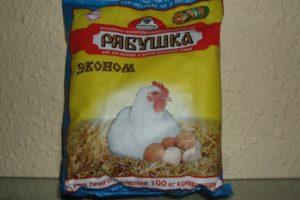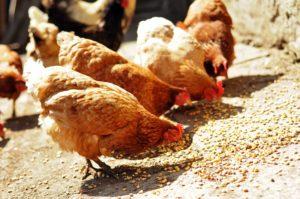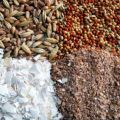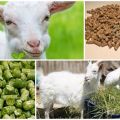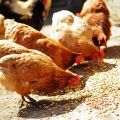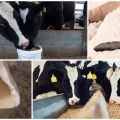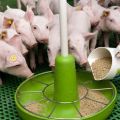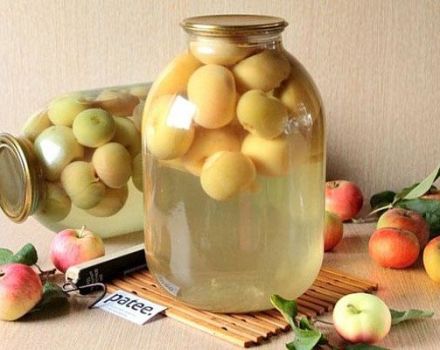Composition of compound feed for feeding broilers and a recipe for making it yourself
Combined feeds provide the supply of trace elements necessary for the normal development of animals. These mixtures are developed taking into account the age of the chickens, so that the birds quickly gain the desired weight. These circumstances should be taken into account when self-preparation of compound feed for broilers. Therefore, it is recommended for novice farmers to purchase ready-made products.
Features of compound feed for broilers
Compound feed (or specialized feed mixture) has a balanced composition, which provides a quick weight gain in chickens, starting from the first day of a bird's life. This product:
- helps to grow a 2.5 kg broiler in a short time;
- ensures the supply of essential trace elements and proteins, thanks to which the bird develops normally;
- it is selected taking into account the age of the bird (for each period of development, ingredients are used in different proportions);
- has a long shelf life (6 months, provided the integrity of the package is preserved);
- allows you to refuse other methods of feeding.
Combined feeds are necessary mixtures, without which it is impossible to grow a full-fledged broiler in 1.5-2 months. The composition of this product varies depending on the brand of the manufacturer. But each compound feed must contain chopped grass, cereals (wheat), corn, as well as ingredients that provide the supply of proteins, minerals and vitamins.
Advantages and disadvantages of using
The benefits of combination feed include the following:
- creates conditions for a quick (within two months) set of the required mass;
- ensures the supply of all trace elements necessary for the development;
- contains natural ingredients that do not cause side effects.
The main disadvantage of combined feeds is due to the fact that a number of manufacturers, instead of natural ones, introduce artificial ingredients into the mixtures. Because of this, birds do not gain weight and suffer from side diseases. When feeding on compound feed, chickens must consume enough water (the proportion is 1: 2). Moreover, such feeding is relatively expensive.
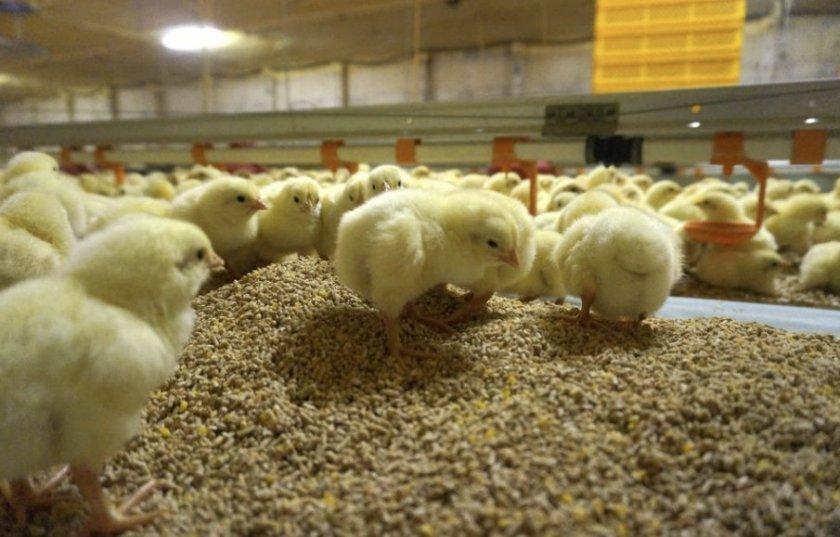
Feed requirements
In addition to these components, the composition of high-quality compound feed should include cereal ingredients. The mixture should not contain antibiotics that stimulate the growth of chickens, but negatively affect the poultry meat. In addition, high-quality compound feed meets the following characteristics:
- when pressed, the granules do not crumble;
- there is no dust in the bag with the mixture;
- color - dark green (rich green indicates a high concentration of herbs in the composition);
- at the initial stage, feed with a high protein content is suitable for young animals, for broilers - with a low one.
For better assimilation of young animals, it is recommended to give combined feed of fine grinding.
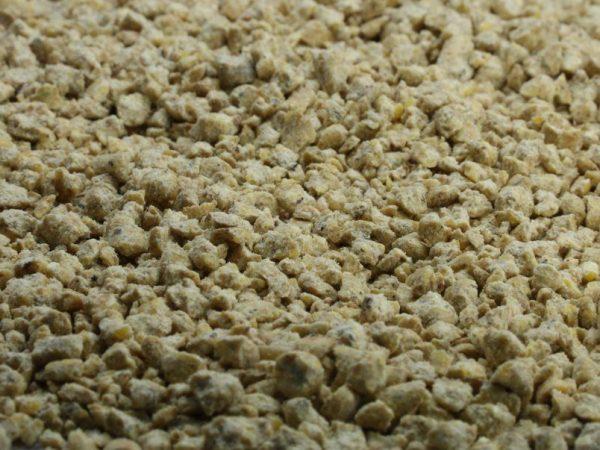
Types and composition of compound feed
At each stage of poultry development, the composition of the feed is changed. This parameter must be strictly controlled, since deviations up or down contribute to the occurrence of diseases. The volume of mix mixes and the number of feeds also depend on the age of the chicks. Until the seventh day, the bird should eat at least eight times daily.
Then, until the second week, this figure is reduced to six. Until the 21st day, chickens are given feed no more than four times. Shortly before slaughter, chickens eat no more than twice a day.
On the first day, no more than 15 grams of compound feed is given. Then, this figure increases by about 5 grams every day. In the period from the 10th to the 17th day, add 2 grams. Further, the amount of feed dispensed is increased by 10 grams every day. By day 30, chicks should eat up to 120 grams of product each time they feed.
The compound feed is produced in the form of a mash and dry mixture. The first is issued ready-made according to the scheme described above (or recommended by the manufacturer). Milk or broth is added to the dry mixture in the proportion of 0.5 liters of liquid per kilogram of feed.
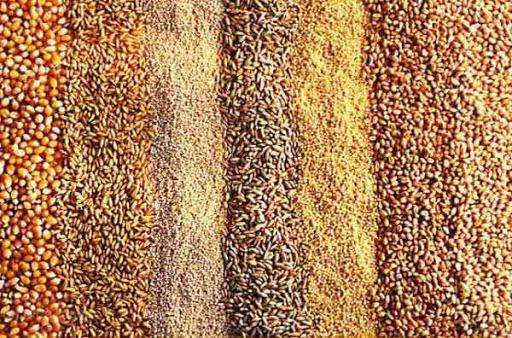
The type of compound feed depends on which feeding method is used:
- Two-stage. This option provides for feeding with mixtures of the PK-5 and PK-6 type.
- Three-stage. The most popular feeding method, which involves the use of mixtures "Start", "Growth" and "Finish".
Mixtures for two-stage feeding cost about 500 rubles more than products for three-stage feeding. Some manufacturers produce pre-launch compound feed. These mixtures are dispensed in the first days after the chicks hatch. Specialized ratings help to select the optimal brand of the product. But, referring to such lists, it is necessary to take into account the above recommendations and requirements for dry food.
Start
The quality of the feed dispensed in the first few days directly affects how the chick will develop. The mixtures that the bird consumes during this period determine:
- the success of bone mass formation in chickens;
- features of the development of immunity;
- the nature of the development of the digestive tract.
In this regard, the starter package must contain corn (36% of the composition), soybean meal (30%) and crushed wheat grains (21%). Also, the quality product includes rapeseed oil and pomace (5.5%), corn gluten and molasses (2.5%).

The starter package is issued from the moment of birth until the 15th day (up to 31st, if two-stage feeding is used). This type of compound feed is produced in the form of fine granules (fine grinding). In addition to the above components, the composition of the feed should include soda and salt, chalk, pork or chicken fat, phosphates and proteins. With the correct composition, this feed provides a daily weight gain of 30 grams.
Growth
In the period from the 14th to the 21st day, chickens are given mixtures that include wheat grains, soybean and sunflower meal, yeast and bone meal obtained from fish or animals. Also, these products should contain amino acids with minerals. The percentage of these components varies depending on the brand of the manufacturer. This is not considered a deviation from the norm and does not affect the development of the bird.
This composition provides a rapid increase in weight: chickens gain up to 50 grams daily.You can achieve a successful result if you give out compound feed intended for the middle period of development three times a day in an amount of 85-115 grams.
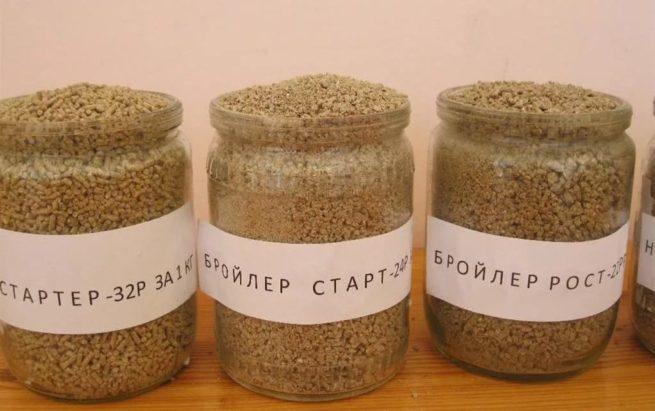
Finish
For monthly chickens, compound feed consisting of large granules is suitable. The basis of the mixtures intended for this period is made up of crushed wheat grains (at least 45% of the total). Additionally, products of this type contain corn (21%), soybean meal (16%), fish bone meal (6%), sunflower greens (5%), vegetable oil (3%).
The remaining 1% falls on limestone flour, mineral and fortified complexes, salt. During this period, with such feeding, broilers gain more than 50 grams daily with two meals a day. In 20 days, the weight of the chickens should increase by 1 kilogram. With a properly selected diet, the weight of broilers after the fifth week exceeds 2 kilograms. But to achieve this, each chicken has to be given 3.3 kg of dry mix.
What compound feed is best for broilers and how much does it cost?
The type of compound feed is selected taking into account the nature of feeding and the purposes for which such a mixture is introduced. The cost of the product depends both on the brand and on the development period of the chicks. The starting mixture, which ensures optimal growth in the first days of life, is sold at a price of 1.35-1.4 thousand rubles per 40 kilograms. Compound feed for the phase of active development, which begins in the fourth week, will cost 1.1 thousand rubles. Large broilers are given compound feed, estimated at 1,000 rubles.
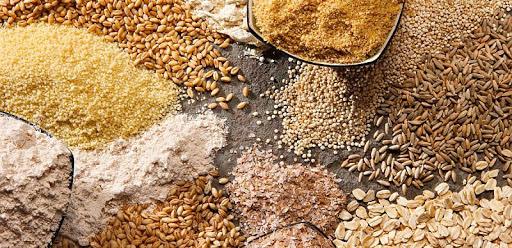
Purina, Schedra Niva, Rozovka and Provimi stand out among the best brands of dry mixes producers.
How to prepare compound feed yourself
To prepare compound feed with your own hands, you will need the following ingredients (weight in grams):
- corn (260);
- wheat (150);
- sunflower greens (120);
- barley and fish bone meal (100 each);
- animal bone meal (80);
- premix and feed fat (20 each);
- chopped grass and shells (40 each);
- sunflower oil and yeast (30 each);
- feed chalk (10).
The specified components must be mixed. For this it is recommended to use a drill with a suitable bit. Then the mixture must be passed through a granulator or crushed in another convenient way. At the end of the procedure, the composition should be infused for 10 minutes.
This recipe is suitable for the preparation of compound feed for both newly hatched chicks and broilers.
